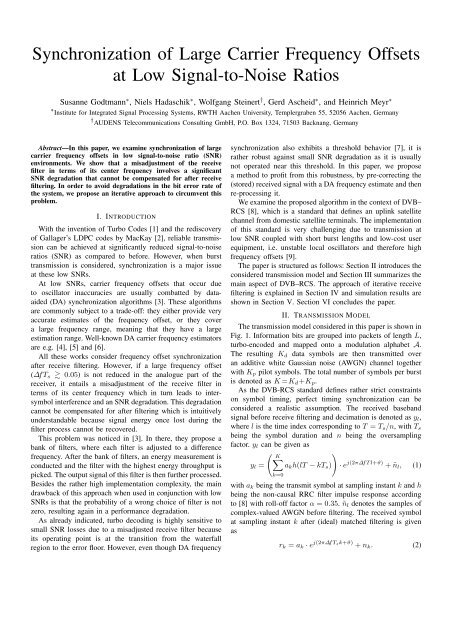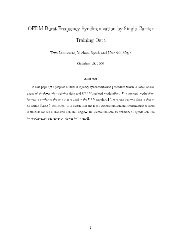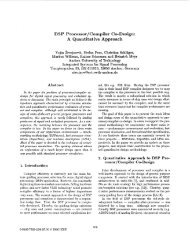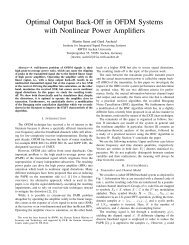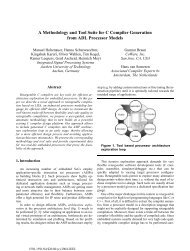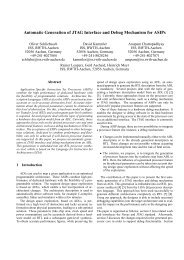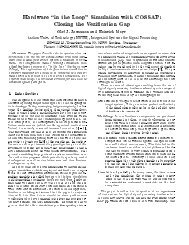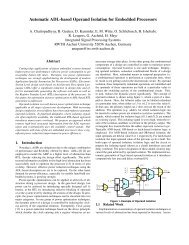Synchronization of Large Carrier Frequency Offsets at ... - IEEE Xplore
Synchronization of Large Carrier Frequency Offsets at ... - IEEE Xplore
Synchronization of Large Carrier Frequency Offsets at ... - IEEE Xplore
- No tags were found...
Create successful ePaper yourself
Turn your PDF publications into a flip-book with our unique Google optimized e-Paper software.
<strong>Synchroniz<strong>at</strong>ion</strong> <strong>of</strong> <strong>Large</strong> <strong>Carrier</strong> <strong>Frequency</strong> <strong>Offsets</strong><strong>at</strong> Low Signal-to-Noise R<strong>at</strong>iosSusanne Godtmann ∗ , Niels Hadaschik ∗ , Wolfgang Steinert † , Gerd Ascheid ∗ , and Heinrich Meyr ∗∗ Institute for Integr<strong>at</strong>ed Signal Processing Systems, RWTH Aachen University, Templergraben 55, 52056 Aachen, Germany† AUDENS Telecommunic<strong>at</strong>ions Consulting GmbH, P.O. Box 1324, 71503 Backnang, GermanyAbstract—In this paper, we examine synchroniz<strong>at</strong>ion <strong>of</strong> largecarrier frequency <strong>of</strong>fsets in low signal-to-noise r<strong>at</strong>io (SNR)environments. We show th<strong>at</strong> a misadjustment <strong>of</strong> the receivefilter in terms <strong>of</strong> its center frequency involves a significantSNR degrad<strong>at</strong>ion th<strong>at</strong> cannot be compens<strong>at</strong>ed for after receivefiltering. In order to avoid degrad<strong>at</strong>ions in the bit error r<strong>at</strong>e <strong>of</strong>the system, we propose an iter<strong>at</strong>ive approach to circumvent thisproblem.I. INTRODUCTIONWith the invention <strong>of</strong> Turbo Codes [1] and the rediscovery<strong>of</strong> Gallager’s LDPC codes by MacKay [2], reliable transmissioncan be achieved <strong>at</strong> significantly reduced signal-to-noiser<strong>at</strong>ios (SNR) as compared to before. However, when bursttransmission is considered, synchroniz<strong>at</strong>ion is a major issue<strong>at</strong> these low SNRs.At low SNRs, carrier frequency <strong>of</strong>fsets th<strong>at</strong> occur dueto oscill<strong>at</strong>or inaccuracies are usually comb<strong>at</strong>ted by d<strong>at</strong>aaided(DA) synchroniz<strong>at</strong>ion algorithms [3]. These algorithmsare commonly subject to a trade-<strong>of</strong>f: they either provide veryaccur<strong>at</strong>e estim<strong>at</strong>es <strong>of</strong> the frequency <strong>of</strong>fset, or they covera large frequency range, meaning th<strong>at</strong> they have a largeestim<strong>at</strong>ion range. Well-known DA carrier frequency estim<strong>at</strong>orsare e.g. [4], [5] and [6].All these works consider frequency <strong>of</strong>fset synchroniz<strong>at</strong>ionafter receive filtering. However, if a large frequency <strong>of</strong>fset(∆f T s 0.05) is not reduced in the analogue part <strong>of</strong> thereceiver, it entails a misadjustment <strong>of</strong> the receive filter interms <strong>of</strong> its center frequency which in turn leads to intersymbolinterference and an SNR degrad<strong>at</strong>ion. This degrad<strong>at</strong>ioncannot be compens<strong>at</strong>ed for after filtering which is intuitivelyunderstandable because signal energy once lost during thefilter process cannot be recovered.This problem was noticed in [3]. In there, they propose abank <strong>of</strong> filters, where each filter is adjusted to a differencefrequency. After the bank <strong>of</strong> filters, an energy measurement isconducted and the filter with the highest energy throughput ispicked. The output signal <strong>of</strong> this filter is then further processed.Besides the r<strong>at</strong>her high implement<strong>at</strong>ion complexity, the maindrawback <strong>of</strong> this approach when used in conjunction with lowSNRs is th<strong>at</strong> the probability <strong>of</strong> a wrong choice <strong>of</strong> filter is notzero, resulting again in a performance degrad<strong>at</strong>ion.As already indic<strong>at</strong>ed, turbo decoding is highly sensitive tosmall SNR losses due to a misadjusted receive filter becauseits oper<strong>at</strong>ing point is <strong>at</strong> the transition from the w<strong>at</strong>erfallregion to the error floor. However, even though DA frequencysynchroniz<strong>at</strong>ion also exhibits a threshold behavior [7], it isr<strong>at</strong>her robust against small SNR degrad<strong>at</strong>ion as it is usuallynot oper<strong>at</strong>ed near this threshold. In this paper, we proposea method to pr<strong>of</strong>it from this robustness, by pre-correcting the(stored) received signal with a DA frequency estim<strong>at</strong>e and thenre-processing it.We examine the proposed algorithm in the context <strong>of</strong> DVB–RCS [8], which is a standard th<strong>at</strong> defines an uplink s<strong>at</strong>ellitechannel from domestic s<strong>at</strong>ellite terminals. The implement<strong>at</strong>ion<strong>of</strong> this standard is very challenging due to transmission <strong>at</strong>low SNR coupled with short burst lengths and low-cost userequipment, i.e. unstable local oscill<strong>at</strong>ors and therefore highfrequency <strong>of</strong>fsets [9].The paper is structured as follows: Section II introduces theconsidered transmission model and Section III summarizes themain aspect <strong>of</strong> DVB–RCS. The approach <strong>of</strong> iter<strong>at</strong>ive receivefiltering is explained in Section IV and simul<strong>at</strong>ion results areshown in Section V. Section VI concludes the paper.II. TRANSMISSION MODELThe transmission model considered in this paper is shown inFig. 1. Inform<strong>at</strong>ion bits are grouped into packets <strong>of</strong> length L,turbo-encoded and mapped onto a modul<strong>at</strong>ion alphabet A.The resulting K d d<strong>at</strong>a symbols are then transmitted overan additive white Gaussian noise (AWGN) channel togetherwith K p pilot symbols. The total number <strong>of</strong> symbols per burstis denoted as K =K d +K p .As the DVB-RCS standard defines r<strong>at</strong>her strict constraintson symbol timing, perfect timing synchroniz<strong>at</strong>ion can beconsidered a realistic assumption. The received basebandsignal before receive filtering and decim<strong>at</strong>ion is denoted as y l ,where l is the time index corresponding to T = T s /n, with T sbeing the symbol dur<strong>at</strong>ion and n being the oversamplingfactor. y l can be given as( K)∑y l = a k h(lT − kT s ) · e j(2π∆fTl+ϑ) +ñ l , (1)k=0with a k being the transmit symbol <strong>at</strong> sampling instant k and hbeing the non-causal RRC filter impulse response accordingto [8] with roll-<strong>of</strong>f factor α =0.35. ñ l denotes the samples <strong>of</strong>complex-valued AWGN before filtering. The received symbol<strong>at</strong> sampling instant k after (ideal) m<strong>at</strong>ched filtering is givenasr k = a k · e j(2π∆fTsk+ϑ) + n k . (2)
Inform<strong>at</strong>ionBitsTurboEncoderMapperPilotSymbolsMUXa kTransmitFiltere j(2πl∆fT+ϑ)DecodedBitsTurboDecoderDemapperr ′ kDA PhaseSyncDA <strong>Frequency</strong>Syncr (i)kReceiveFiltery (i)ln ke −j(2πl∆ˆfT)Fig. 1.System model <strong>of</strong> proposed approachNote th<strong>at</strong> in case <strong>of</strong> non-ideal receive filtering r k containsdistortions due to inter-symbol interference and suffers froman SNR loss.Unit energy symbols are assumed, i.e. E s = |a k | 2 =1.Furthermore, n k are the filtered samples <strong>of</strong> complexvaluedAWGN with independent real and imaginary parts, eachhaving zero-mean and variance N 0 /(2E s ). In addition to thenoise component, a phase <strong>of</strong>fset ϑ and a frequency <strong>of</strong>fset ∆fare introduced by the physical channel and the local oscill<strong>at</strong>ors.As the DVB–RCS standard employs short bursts, phase andfrequency <strong>of</strong>fset can assumed to be constant for the dur<strong>at</strong>ion<strong>of</strong> one burst.For l<strong>at</strong>er use, we define the K-dimensional vector r andthe (n·K)-dimensional vector y as the conc<strong>at</strong>en<strong>at</strong>ion <strong>of</strong> thesymbols r k and y l , respectively.III. DVB–RCS PARAMETERSDVB–RCS disposes two types <strong>of</strong> traffic bursts, the ATMburst with the length L = 424 and the MPEG2 burstwith L = 1504. As the w<strong>at</strong>erfall region for a turbo coded frameis usually more distinct the longer the frame is, the MPEG2burst is more critical for our problem. Therefore, we limit ourinvestig<strong>at</strong>ions on the MPEG2 burst. As DVB–RCS makes use<strong>of</strong> frequency hopping, bursts are generally neither transmittedin consecutive time-slots nor <strong>at</strong> the same frequency. Thus,receiver synchroniz<strong>at</strong>ion needs to be performed burst by burst.Since DVB–RCS terminals are supposed to be r<strong>at</strong>her lowcost,the frequency <strong>of</strong>fset can be significant [9]. An <strong>of</strong>fset <strong>of</strong>up to 20kHz may occur. Depending on the symbol r<strong>at</strong>e, thismay result in normalized <strong>of</strong>fsets ∆f T s up to 0.32, th<strong>at</strong> cannotbe handled by the receive filter. Therefore, one has to deal witha pre-compens<strong>at</strong>ion before m<strong>at</strong>ched filtering <strong>at</strong> the receiver.Earlier investig<strong>at</strong>ions in [10] have shown th<strong>at</strong> for DA frequencysynchroniz<strong>at</strong>ion a pre-/mid-/postamble (P-M-P) structurewith a percentage η = K p /K = 0.08 is close tooptimal for the MPEG2 burst. The P-M-P pilot constell<strong>at</strong>ionis dimensioned such th<strong>at</strong> pre- and postamble consist <strong>of</strong> K p /4each. The residual K p /2 pilot symbols are distributed equallybetween pre- and postamble.IV. FREQUENCY SYNCHRONIZATION PRIOR TO MATCHEDFILTERINGAs the received signal before m<strong>at</strong>ched filtering suffers fromaliasing, d<strong>at</strong>a-aided frequency synchroniz<strong>at</strong>ion is usually performedafter the receive filter. However, when large frequency<strong>of</strong>fsets occur due to oscill<strong>at</strong>or inaccuracies, the (no longerm<strong>at</strong>ched) receive filter cuts <strong>of</strong>f a significant amount <strong>of</strong> signalenergy. The SNR degrad<strong>at</strong>ion versus the frequency <strong>of</strong>fset isillustr<strong>at</strong>ed in Fig. 2 for different roll-<strong>of</strong>f factors. The filtergiven in [8] uses the roll-<strong>of</strong>f factor α =0.35. Note th<strong>at</strong> thehigher the roll-<strong>of</strong>f factor is chosen, the less energy is lost dueto a misadjusted receive filter.Loss <strong>of</strong> Energy [dB]2.521.510.5α =0.2α =0.35 from [8]α =0.400 0.05 0.1 0.15 0.2 0.25 0.3∆f TFig. 2.SNR loss <strong>of</strong> the receive filter versus ∆f T sIn order to circumvent this SNR degrad<strong>at</strong>ion, one commonapproach, which is for instance described in [3], uses a bank<strong>of</strong> N MF filters as shown exemplarily in Fig. 3. The choice <strong>of</strong>the correct pre-correction ˜∆f j , and therefore <strong>of</strong> the best filter,is usually based on an energy measurement. Hence, the signalfrom the output <strong>of</strong> this filter is chosen for further processing.However, especially <strong>at</strong> low SNR the choice <strong>of</strong> the filteris not forcefully optimal. Even if a correct choice could beguaranteed, the resolution can never be as accur<strong>at</strong>e as in ourapproach and definitely involves an SNR loss.In our approach th<strong>at</strong> is depicted in Fig. 1, we store thereceived signal y (0) before receive filtering. We then filter itwith the root raised cosine filter defined in [8] and obtainthe signal r (0) . As already indic<strong>at</strong>ed in the introduction,this receive filter is no longer m<strong>at</strong>ched due to the (large)frequency <strong>of</strong>fset <strong>of</strong> the channel. Therefore, r (0) suffers froman SNR degrad<strong>at</strong>ion as indic<strong>at</strong>ed in Fig. 2. However, accepting
ye −j2π ˜∆f 1 Tle −j2π ˜∆f 2 Tle −j2π ˜∆f NMF −1 Tle −j2π ˜∆f NMF Tlhhhhr [1]r [2]r [NMF −1 ]r [NMF ]Fig. 3. Filter bank approach from [3]Choice <strong>of</strong> M<strong>at</strong>ched Filterr = r [j]this degrad<strong>at</strong>ion and performing d<strong>at</strong>a-aided (DA) frequencyestim<strong>at</strong>ion anyway, yields estim<strong>at</strong>ion results for the frequency<strong>of</strong>fset th<strong>at</strong> are hardly degraded by the SNR loss (due to therel<strong>at</strong>ively weak slope <strong>of</strong> the <strong>at</strong>tainable mean squared estim<strong>at</strong>ionerror (MSEE) versus the SNR. The respective MSEEs{ } }ε MSE ∆ˆfTs =E{(∆f − ∆ˆf) 2 Ts2 (3)are shown in Tab. I.TABLE IMSEE FOR DA FREQUENCY ESTIMATION BASED ON r (0) ;E b /N 0 =1.2 DB; r =1/3∆f T s =0∆f T s =0.05∆f T s =0.1∆f T s =0.2∆f T s =0.3ε MSE{∆ˆfTs}1.05 · 10 −101.07 · 10 −101.14 · 10 −101.42 · 10 −101.82 · 10 −10Making use <strong>of</strong> this estim<strong>at</strong>e ∆ˆfT s , the received signal y (0)is corrected, yielding:y (1)l= y (0)l· e −j(2πl∆ˆfT) . (4)The sequence y (1) consisting <strong>of</strong> the conc<strong>at</strong>en<strong>at</strong>ion <strong>of</strong> all y (1)lis then again processed by the receive filter and, subsequentlysynchronized in frequency and phase. Since the estim<strong>at</strong>ionperformance obtained in the first iter<strong>at</strong>ion is accur<strong>at</strong>e enoughfor the given <strong>of</strong>fsets, it is sufficient to have one singleiter<strong>at</strong>ion between the DA frequency synchroniz<strong>at</strong>ion unit andthe m<strong>at</strong>ched filter. Therefore, the i in Fig. 1 is either zero orone.For details concerning the utilized DA frequency estim<strong>at</strong>orand DA phase estim<strong>at</strong>or, please refer to [10]. It is importantto note th<strong>at</strong> the estim<strong>at</strong>ors are efficient in the consideredSNR region, meaning th<strong>at</strong> their mean squared estim<strong>at</strong>ion error(almost) coincides with the DA Cramér-Rao Bound for theconsidered pilot constell<strong>at</strong>ion.V. SIMULATIONSAs already indic<strong>at</strong>ed in Section III, the simul<strong>at</strong>ion results inthis paper are presented for the MPEG2 burst with L = 1504.Details concerning the code and the interleaver can be foundin the standard [8]. The modul<strong>at</strong>ion is Gray-mapped QPSK.We consider a code r<strong>at</strong>e <strong>of</strong> r =1/3.Fig. 4 shows the convergence in terms <strong>of</strong> the frame error r<strong>at</strong>e(FER) versus the number <strong>of</strong> turbo decoding iter<strong>at</strong>ions. Thecurves correspond to different initial frequency <strong>of</strong>fsets ∆f T s .Please note th<strong>at</strong> in Fig. 4(a) the curve with the hexagrammarkers, corresponding to ∆f T s =0.3, is not missing, but isunderne<strong>at</strong>h the curve with the diamond markers (∆f T s =0.2)and th<strong>at</strong> all curves coincide in Fig. 4(b).Fig. 4(a) depicts the results th<strong>at</strong> are obtained when bothsynchroniz<strong>at</strong>ion and detection are performed after receivefiltering the sequence y (0) . As already indic<strong>at</strong>ed, these resultsseverely suffer from the SNR degrad<strong>at</strong>ion due to the fact th<strong>at</strong>the filter is no longer m<strong>at</strong>ched. As a turbo code is employedfor error protection, this SNR loss has f<strong>at</strong>al effects on the FERdue to its oper<strong>at</strong>ing point near the w<strong>at</strong>erfall region.The results shown in Fig. 4(b) are based on the proposedapproach depicted in Fig. 1. The signal y (0) is here filteredand subsequently used for DA frequency synchroniz<strong>at</strong>ion.Afterwards, frequency pre-compens<strong>at</strong>ion according to (4) isapplied. Then, y (1) is newly filtered yielding r (1) . Thissequence is then used for DA synchroniz<strong>at</strong>ion (frequency andphase) and afterwards for detection. It is visible, th<strong>at</strong> <strong>at</strong> thecost <strong>of</strong> slightly increased complexity (receive filtering and DAfrequency synchroniz<strong>at</strong>ion is performed twice) an enormousperformance gain for large frequency <strong>of</strong>fsets ∆f T s can beobtained, as compared to a system where the detection is basedon r (0) .A FER comparison <strong>of</strong> our approach against the systemshown in Fig. 3 is not carried out for two reasons. Firstly,as due to the discreteness <strong>of</strong> trial frequencies ∆˜f in Fig. 3,it is clear th<strong>at</strong> its performance will be degraded as comparedto our approach. Secondly, its complexity is higher (due tomultiple filtering <strong>of</strong> the signal).Note, th<strong>at</strong> it is possible to further refine the frequency andphase estim<strong>at</strong>e by a turbo synchroniz<strong>at</strong>ion unit, as proposedin [11]. However, investig<strong>at</strong>ions in [10] have shown th<strong>at</strong> theperformance gains in terms <strong>of</strong> the achievable FER are barelyvisible for the MPEG2 burst in the context <strong>of</strong> DVB–RCS.There, it is demonstr<strong>at</strong>ed th<strong>at</strong> the accuracy <strong>of</strong> a feed-forwardDA frequency and phase synchroniz<strong>at</strong>ion is sufficient.VI. CONCLUSIONThe main issue with large frequency <strong>of</strong>fsets is th<strong>at</strong> thereceive filter is no longer m<strong>at</strong>ched and, thus, entails intersymbolinterference and a loss in the SNR. These degrad<strong>at</strong>ionsmay be f<strong>at</strong>al for turbo coded systems as they are usuallyoper<strong>at</strong>ed <strong>at</strong> the transition from the w<strong>at</strong>erfall region to the
10 010 010 −110 −1FER10 −21 2 3 4 5 6 7 8 9 10∆f T s =0∆f T s =0∆f T s =0.05∆f T s =0.0510 −3∆f T s =0.110 −3∆f T s =0.1∆f T s =0.2∆f T s =0.2∆f T s =0.3∆f T s =0.310 −41 2 3 4 5 6 7 8 9 1010 −4(a) Detection based on r (0) (b) Detection based on r (1)Number <strong>of</strong> Turbo Decoding Iter<strong>at</strong>ionsNumber <strong>of</strong> Turbo Decoding Iter<strong>at</strong>ionsFER10 −2Fig. 4.FER vs. Iter<strong>at</strong>ions; L = 1504, E b /N 0 =1.2 dB, r =1/3, η =0.08, QPSKerror floor. In this paper, we demonstr<strong>at</strong>e th<strong>at</strong> DA frequencyestim<strong>at</strong>ion is rel<strong>at</strong>ively robust against distortions due to nonidealreceive filtering. We make use <strong>of</strong> this robustness andproduce a frequency estim<strong>at</strong>e th<strong>at</strong> is subsequently used to precorrectthe (stored) received signal before receive filtering.Afterwards, m<strong>at</strong>ched filtering, synchroniz<strong>at</strong>ion and turbo decodingis performed on this pre-corrected sequence. We showby means <strong>of</strong> simul<strong>at</strong>ion th<strong>at</strong> the performance gain achievableby this approach is high.REFERENCES[1] C. Berrou, A. Glavieux, P. Thitimajshima, “Near Shannon Limit Error-Correcting Coding and Decoding: Turbo-Codes,” in Proc. <strong>of</strong> <strong>IEEE</strong>Intern<strong>at</strong>ional Conference on Communic<strong>at</strong>ions (ICC), vol.2,Geneva,Switzerland, May 1993, pp. 1064–1070.[2] D.J.C. MacKay, R.M. Neal, “Near Shannon Limit Performance <strong>of</strong> LowDensity Parity Check Codes,” IEE Electronics Letters, vol. 32, no. 18,pp. 1645–1646, Aug. 1996.[3] H. Meyr, M. Moeneclaey, S. Fechtel, Digital Communic<strong>at</strong>ion Receivers:<strong>Synchroniz<strong>at</strong>ion</strong>, Channel Estim<strong>at</strong>ion and Signal Processing, 1st ed.New York, NY: John Wiley & Sons, 1998.[4] M. P. Fitz, “Planar Filtered Techniques for Burst Mode <strong>Carrier</strong> <strong>Synchroniz<strong>at</strong>ion</strong>,”in Proceedings <strong>of</strong> <strong>IEEE</strong> Globecom, Phoenix, Arizona, USA,Dec. 1991.[5] M. Luise, R. Reggiannini, “<strong>Carrier</strong> <strong>Frequency</strong> Recovery in All-DigitalModems for Burst-Mode Transmissions,” <strong>IEEE</strong> Transactions on Communic<strong>at</strong>ions,vol. 43, no. 2/3/4, pp. 1169–1178, Feb.-Apr. 1995.[6] U. Mengali, M. Morelli, “D<strong>at</strong>a-Aided <strong>Frequency</strong> Estim<strong>at</strong>ion for BurstDigital Transmission,” <strong>IEEE</strong> Transactions on Communic<strong>at</strong>ions, vol. 45,no. 1, pp. 23–25, Jan. 1997.[7] D. C. Rife, R. R. Boorstyn, “Single-Tone Parameter Estim<strong>at</strong>ion fromDiscrete-Time Observ<strong>at</strong>ions,” <strong>IEEE</strong> Transactions on Inform<strong>at</strong>ion Theory,vol. 20, no. 5, pp. 591–598, Sept. 1974.[8] ETSI, “Digital Video Broadcasting (DVB); Interaction Channel forS<strong>at</strong>ellite Distribution Systems; (EN 301 790 V1.4.1),” Sept. 2005.[9] ——, “Digital Video Broadcasting (DVB); Interaction Channel forS<strong>at</strong>ellite Distribution Systems; Guidelines for the use <strong>of</strong> EN 301 790;(TR 101 790 V1.2.1),” Jan. 2003.[10] S. Godtmann, N. Hadaschik, W. Steinert, A. Pollok, G. Ascheid,and H. Meyr, “Coarse and Turbo <strong>Synchroniz<strong>at</strong>ion</strong>: A Case-Study forDVB-RCS,” in Proc. <strong>of</strong> Joint NewCom-Acorn Workshop 2006, Vienna,Austria, Sep. 2006.[11] N. Noels, C. Herzet, A. Dejonghe, V. Lottici, H. Steendam, M.Moeneclaey, M. Luise, L. Vandendorpe, “Turbo <strong>Synchroniz<strong>at</strong>ion</strong>: AnEM Algorithm Interpret<strong>at</strong>ion,” in Proc. <strong>of</strong> <strong>IEEE</strong> Intern<strong>at</strong>ional Conferenceon Communic<strong>at</strong>ions (ICC), vol. 4, Anchorage, Alaska, USA, May2003, pp. 2933–2937.


